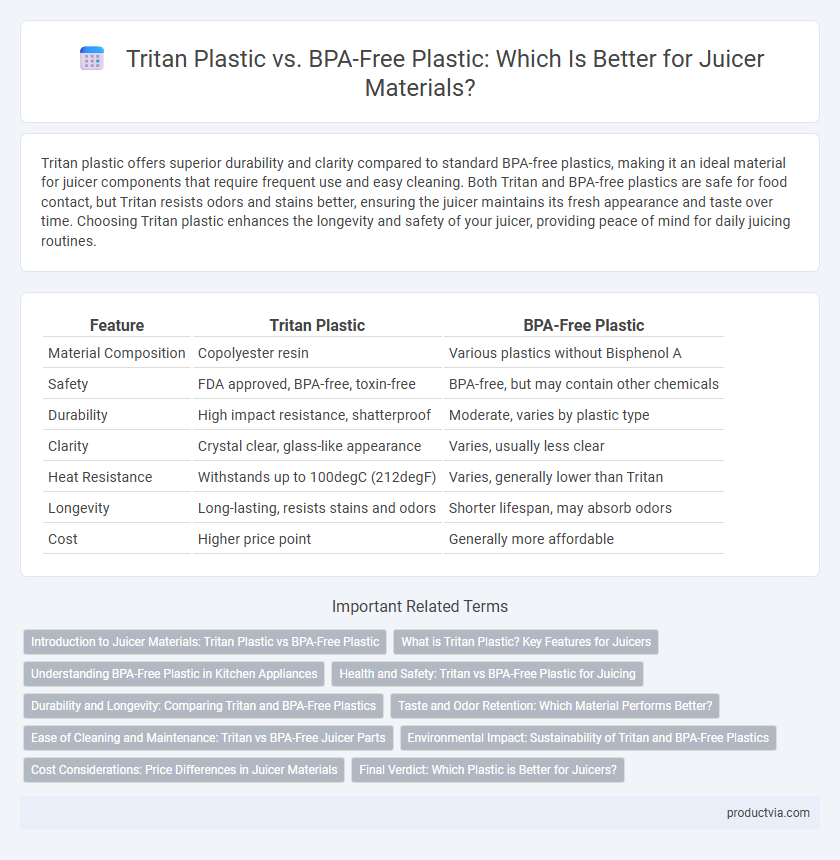Tritan plastic offers superior durability and clarity compared to standard BPA-free plastics, making it an ideal material for juicer components that require frequent use and easy cleaning. Both Tritan and BPA-free plastics are safe for food contact, but Tritan resists odors and stains better, ensuring the juicer maintains its fresh appearance and taste over time. Choosing Tritan plastic enhances the longevity and safety of your juicer, providing peace of mind for daily juicing routines.
Table of Comparison
| Feature | Tritan Plastic | BPA-Free Plastic |
|---|---|---|
| Material Composition | Copolyester resin | Various plastics without Bisphenol A |
| Safety | FDA approved, BPA-free, toxin-free | BPA-free, but may contain other chemicals |
| Durability | High impact resistance, shatterproof | Moderate, varies by plastic type |
| Clarity | Crystal clear, glass-like appearance | Varies, usually less clear |
| Heat Resistance | Withstands up to 100degC (212degF) | Varies, generally lower than Tritan |
| Longevity | Long-lasting, resists stains and odors | Shorter lifespan, may absorb odors |
| Cost | Higher price point | Generally more affordable |
Introduction to Juicer Materials: Tritan Plastic vs BPA-Free Plastic
Tritan plastic offers exceptional durability and clarity, making it a popular choice for juicer containers due to its resistance to shattering and staining. BPA-free plastic ensures safety by eliminating bisphenol A, a chemical linked to health risks, providing peace of mind when extracting fresh juice. Both materials combine safety and functionality, but Tritan's advanced composition often delivers higher impact resistance and long-lasting transparency in juicer applications.
What is Tritan Plastic? Key Features for Juicers
Tritan plastic is a high-performance, BPA-free polymer known for its exceptional durability and clarity, making it ideal for juicer components like pitchers and containers. It offers superior impact resistance, dishwasher safety, and does not retain odors or stains, ensuring long-lasting hygiene and freshness. Unlike generic BPA-free plastics, Tritan combines safety with premium strength and clarity, enhancing both the functionality and aesthetics of juicers.
Understanding BPA-Free Plastic in Kitchen Appliances
BPA-free plastic in juicers ensures the absence of Bisphenol A, a chemical linked to health risks, making it a safer material for food contact. Tritan plastic, a type of BPA-free copolyester, combines durability, dishwasher safety, and resistance to odors and stains, enhancing the longevity and hygiene of juicer components. Choosing Tritan over generic BPA-free plastics provides added confidence in quality and performance while maintaining health-conscious standards in kitchen appliances.
Health and Safety: Tritan vs BPA-Free Plastic for Juicing
Tritan plastic offers superior durability and is completely BPA-free, ensuring no harmful chemicals leach into freshly extracted juice, promoting safe consumption. BPA-free plastics, while eliminating bisphenol A, may still contain other compounds that could pose health risks under heat or prolonged use. Choosing Tritan for juicer materials guarantees a safer, long-lasting option that maintains juice purity and supports overall health.
Durability and Longevity: Comparing Tritan and BPA-Free Plastics
Tritan plastic offers superior durability and longevity compared to standard BPA-free plastics used in juicer materials, resisting scratches, cracks, and discoloration over time. Its impact-resistant properties ensure the juicer components maintain clarity and functionality even after extended use. While BPA-free plastics provide a safer alternative to traditional plastics, Tritan specifically excels in maintaining structural integrity, making it a preferred choice for high-quality, long-lasting juicers.
Taste and Odor Retention: Which Material Performs Better?
Tritan plastic excels in taste and odor retention for juicer materials due to its high resistance to staining and absorption of flavors, ensuring the juice maintains its pure, fresh taste over time. BPA-free plastics vary widely, with some types prone to retaining odors and residues that can affect the flavor profile of the juice. Consumers seeking optimal taste preservation should consider Tritan plastics as the superior option due to their durability and resistance to flavor contamination.
Ease of Cleaning and Maintenance: Tritan vs BPA-Free Juicer Parts
Tritan plastic juicer parts offer superior ease of cleaning due to their non-porous surface, which resists stains and odors more effectively than many BPA-free plastics. BPA-free materials vary widely, with some prone to retaining food residue and discoloration, requiring more frequent and thorough maintenance. Choosing Tritan ensures a durable, dishwasher-safe option that maintains clarity and hygiene over prolonged use.
Environmental Impact: Sustainability of Tritan and BPA-Free Plastics
Tritan plastic, known for its durability and safety, is BPA-free and often recyclable, reducing long-term environmental waste compared to traditional plastics. BPA-free plastics vary widely; some are made from less sustainable materials and may not be as easily recyclable, affecting their environmental footprint. Choosing juicers with Tritan components supports sustainability due to its resistance to deterioration and extended product lifespan, which minimizes plastic pollution.
Cost Considerations: Price Differences in Juicer Materials
Tritan plastic offers high durability and shatter resistance but typically comes at a higher price point compared to standard BPA-free plastics used in juicers. BPA-free plastics are more cost-effective while ensuring safety from chemical leaching, making them a popular choice for budget-conscious consumers. Juicer models with Tritan components often target premium markets with longer lifespan benefits justifying the price difference.
Final Verdict: Which Plastic is Better for Juicers?
Tritan plastic offers superior durability and clarity compared to standard BPA-free plastics, making it highly resistant to cracking and discoloration in juicers. BPA-free plastics ensure safety by eliminating harmful bisphenol A but may lack the enhanced strength and longevity found in Tritan materials. For juicers, Tritan plastic is the better choice, combining safety with long-lasting performance and aesthetic appeal.
Tritan plastic vs BPA-free plastic for juicer materials Infographic

 productvia.com
productvia.com